


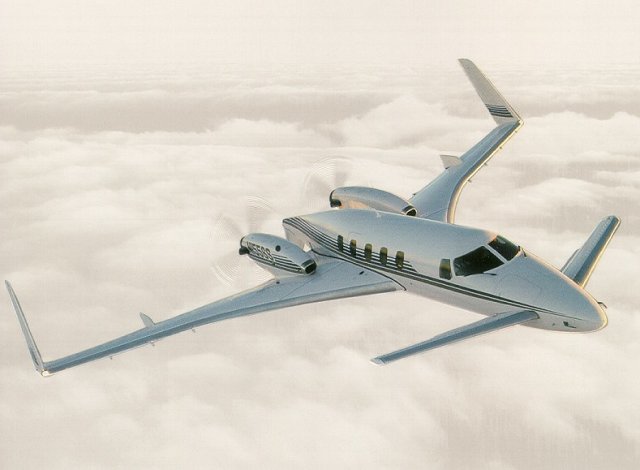
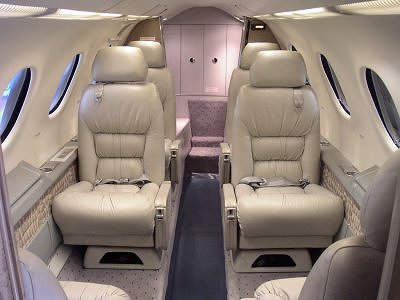
|
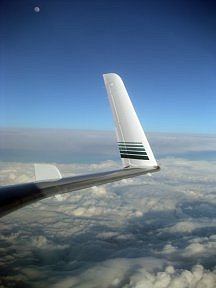
|
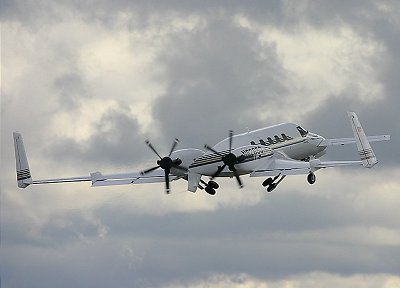
|
In the fall of 1986 I went to work at Beech Aircraft Corporation in the position of Demonstration Pilot and Product Specialist on the then new Beechjet program. It was still Beech at this point in time even though Raytheon had purchased the company. It was Beech until Raytheon made their move after Mrs. Beech died in 1993. The Mitsubishi Diamond Two was not yet officially named the Beechjet. February 15, 1986
In the Fall of 1989, as I recall, Beech received a contract to supply the Air Force with Beechjets to be used for training. This airplane became the T-1A Jayhawk. To do this the airplane had to be produced in the USA. At the time the airplane was produced in Japan by Mitsubishi Heavy Industries. The components were then shipped to Wichita in big green boxes where Beech assemblied them into the Beechjet. So, the production had to be hurriedily moved to the the Beech factory in Wichita. This took something like a year-and-a-half to accomplish. In the meantime there was little or no Beechjet activity so I transferred to the Starship program which was just going to production.
The first time I ever saw a Starship and had any feeling about its looks was the first time I saw the first production airplane. The airplane is without question one of the best looking airplanes I have ever seen when it's in a setting with nothing else with which one can judge scale, which means in flight. On the ground with people, or cars, or other airplanes, to me the airplane takes on a rather ungainly, and from some angles, even a grotesque look.
In my experience showing and demostrating the Starship all over the world people either loved how it looked or they hated it. There was no in between. Consistantly the people who didn't like it told us that the two areas they disliked the most was the long main landing gear struts and the extremely thick (fat) wing roots. We always tried to explain the reason for these and other unusual aspects of the design but it never made much difference to those people because they just didn't like the way the airplane looked. It's impossible to overturn people's subjective feelings with logic and reason.
The shape and size of the airplane did required some special precautions on the ground. You always had to have an observer on the ramp in front of the airplane to clear the propellers for you during engine start. The Starship was the producer of as well as the recipient of much so called "hangar rash". The size of the airplane made it a challenge to move with a tug especially in tight spaces. The geometry of the wing planform produced what's called wing tip growth. During towing, and during taxi as well, as the airplane is maneuvered the wing tips move in an increasing arc out away from the radius of the turn so you, at first, might think you have enough room to turn but as the wingtips "grow" it's easy to contact another airplane or the edge of the hangar door. During taxi it was very difficult to keep track of the wingtips because they were hard to see from the cockpit.
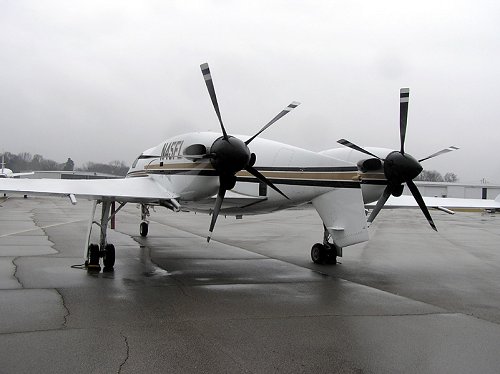
The Starship had all kinds of appendages extending from every surface that all seemed to be about head high. The vortilons on the wing leading edges, the huge high tech pitot tubes, angle of attack probes, ice detectors, the props in the rear all could produce rather nasty head gouges if you wern't careful. A young tall pilot flying with us stepped of the airstair door in Mexico City one day, turned right and was immediately knocked flat after colliding with the trailing edge of the forward wing. His gouge was across the middle of his forehead.
Related to the looks of the Starship was the quality of the construction; the "fit-and-finish" if you will. One of the most unfortunate aspects of this airplane is that Beech (Raytheon) chose to skip, at least for the most part, a step in it's development process. When building a new airplane you first build a prototype. This airplane (or airplanes) is usually an airplane built in the most expedient manner possible to get it in the air quickly and prove the design. During the time that the prototype is doing it's thing the design of the first production airplane is continuing. This is the phase when all the refinement of the individual components is carried out to bring the design up to production standards. This is the phase that Beech management chose to skip to save money. All they wanted to know at this point in time was, "Can we certify what we have." If the answer was yes then they went into production with it. In other words, the airplane never got past the prototype phase. As a result most people thought the airplane was either a great looking prototype unit, or, a very poor quality production airplane.
The cabin of the Starship was very well done form the start. Beech still feels today that a roomy well apointed cabin is all it takes to sell airplanes. This is a carryover from the day's of the KingAir when performance wasn't that big a factor. This philosophy became obsolete when jets appeared on the scene and performance became the name of the game. Now of course, you must offer both.
The original interior was eight place. At NC-21 two seats were removed in an attempt to improve the range payload. This, "New model", was dubbed the 2000A. Retained was the ridiculous compartment opposite the main cabin door that originally housed, and was designed to enclose, the toilet using two huge doors. In the 2000A the toilet was moved to the aft cabin but the storage compartment and the huge doors were retained. It was always my opinion that the space taken up by this storage compartment could have been much better utilized, and the inconvienence of these doors could have been eliminated.
Further inconvience, in my opinion, was designed into the cabin with the solid doors installed on the baggage compartment aft of the toilet. The aft cabin divider and these narrow doors only served to make the already difficult chore of loading baggage even more difficult.
The structure of the Starship, of course, was built of composite materials. The individual parts of each component were hand layups. The major parts were honeycomb with a carbon fiber face sheet bonded to each side. These parts were about three-quarters of an inch thick. The fuselage was two halves a left and a right. The wing was two parts an upper and a lower. The individual parts were then bonded together in exactly the same way as a Revell plastic model plane is.
The benefits of building an airplane in this manner are that the the fuselage and wing are continuous structures instead of a lot of pieces fastened together with bolts and rivets as in conventional designs. This makes the airplane much stronger, less fatigue resistant, and virtually imune to corrosion. This process also leaves the exterior surface very smooth.
The fuselage when bonded together was basically a single piece and thus required very little sealant to seal it against pressure loss. This also placed less demands on the pressurization system because the leak rate was so low. The pressurization system was very smooth even though the airplane did not have an electronic controller.
The problem with the composite construction from a marketing standpoint was that nobody cared. One customer asked about the advantages of composites and after we explained it he said, "I've been flying a 350 for ten years and it hasn't fatiqued or corroded out from under me yet." We were never able, by my observations, to convince people of the advantages of composite construction.
The big disadvantage of composite construction, as it was used in the Starship, was that it was very labor intensive. All the parts were layed up by hand, as pointed out earlier. When you build a composite structure quality control takes on a whole new meaning. You cannot inspect the parts and assemblies after the fact. All of the processes must be meticulously controlled. The parts for example were all layed up in a temperature controlled clean room; inspection was done using expensive ultrasound techniques. The principle being that if the methods and procedures are good the results will be good. The problem is that the customer doesn't apprieciate all of this technology because all he ever see's of it is a higher price.
The engines on the Starship were rated at 1200 SHP for takeoff; 1000 shp for all other phases of flight. This gave the Starship a power-to-weight ratio of 6.2 lbs/hp. The KingAir 350 by comparison had a power-to-weight ratio of 7.14 lbs/hp. The Takeoff Field Length (TOFL) from the respective AFM for a 3000 foot elevation airport, at 20 degrees centigrade and maximum gross weight is 4664 feet for the Starship and 4697 feet for the 350. Virtually the same even though the Starship has a more favorable power-to-weight and 100 pounds less total weight. Under these conditions the highest elevation the Starship would be able takeoff from is 5700 feet (Denver Centennial = 5883 feet) while the 350 could takeoff from a 9000 foot elevation airport (Telluride, Coloado = 9078 feet).
The engines on the early Starship's (up to serial number 30) were lasting only about 700 hours. I don't know what the power output actually was but we were only able to cruise 305 KTAS (Heck, a 350 could do that!), at most. I understand that the later airplanes (serial numbers 31 and after) will true 335 knots or so. This increase must be due to engine/propeller improvements since I am not aware of any significant changes to the airplane e.g., drag reduction. (Perhaps someone reading this could shed some light on how this speed increase was achieved for me and the rest of our readers.)
During the time that I operated the Starship we did have one modification to the exhaust pipes which increased the cruise speed at the higher altitudes. 5-6 KTAS at 35,000 feet.
The startup and preflight procedures for the Starship were virtually identical to those of a KingAir 350. The systems were deratives of the 350 so operation was the same.
The one system that was different was the fuel system. The Starship held just under 3800 pounds of fuel (1900 pounds per side) in four tanks in the inboard wing. The sharply swept forward strake tank held all of the fuel on each side except for 570 pounds which was in a bladder tank located aft of the strake tank inside of the wing itself. The strake tank was a wet structure. In flight the fuel in the aft tank was used first and had to be pumped into the strake tank where it was supplied to the engine on that side. As fuel in the aft tank was consumed the center of gravity(CG) move sharply forward and if the airplane was loaded full of fuel and people the CG would move out of the envelope forward during cruise. The only way to prevent this was to significantly reduce the fuel load and thus the range.

|
Pilot's | |
| Co-pilot's | 
|
|
|
The avionics system was supposed to be, "The star of the show," so to speak but was, in a lot of ways, a bit underwelming. There was little or no integration in the presentation since the the glass tubes only replaced the mechanical instruments of earlier designs. Without being fully integrated this doesn't really accomplish much. One thing it does accomplish is use flexibility which allows the pilot to program the system for the way he/or she likes to use the system. The tubes also allow reversionary modes which it valuable. The system did have an Attitude Heading Reference System (AHRS) instead of the antiquated spinning mass gyros, a digital bus system, and an Engine Instrument Crew Alert System (EICAS) for system fault notification.
The digital autopilot was superb.
The NAV system (FMS) was, as I recall, DME/DME primary, and VLF/OMEGA. The Starship's I operated did not have GPS! It's a good thing that we operated in the DME/DME environment of the US most of the time because I never had much confidence in the VLF/OMEGA system although I flew this airplane all over the world and do not recall many problems with navigation. When we went over the water we always carried a handheld GPS as a backup. On one occasion while decending into Wichita in clear weather the entire database went to data heaven. It just got wiped out for some reason. We manually reinitialized the system, told it where the airport was and pressed on. When I called Collins after landing and explained what happened their comment was, "That can't happen." We never experienced that particular problem again, but on another occasion while flying between Reykjavik, Iceland and Stavanger, Norway we found that we could not input into the FMS. When we departed Stavanger for Copenhagen everything worked just fine.
AERODYNAMICS

The Starship had swept wings. Rather unusual for a turboprop. Swept wings, of course, reduce drag by making the wing think that it is thinner than it actually is. The swept wing on the Starship also provided the required longitudinal (pitch) stability due to the fact that the aerodynamic center of the wing is placed aft of the CG. The Starship is essentially a flying wing. Longitudinal stability is provided by the main wing. The "horizontal tail", or canard surface is placed in front of the main wing. This does two things: it provides a constant upload to balance the negative pitching moment of the wing and, provides pitch control through an elevator on the trailing edge. The canard is actually destabilizing and so does not contribute to longitudinal stability. The swept wing also allowed the vertical stabilizers, which Beech called Tip Sails, to be attached to the wing tips. This mounting placed these surfaces at the correct position to serve as stabilizing surfaces and rudders as in conventional designs. The Tip Sails are canted in six degrees so that the lift vector passes through the vertical CG of the airplane to all but eliminate any roll due to yaw effect during an engine failure. The movable surfaces on the trailing edge of the wings at the tips were elevons which provide lateral (roll) control by deflecting differentally as the control wheel in the cockpit is rotated, and deflecting simultaneously up or down to augment pitch control when the control column is pushed or pulled. Pitch control is also effected by the elevator mounted on the trailing edge of the canard. The elevator and the elevons move in opposite directions since the elevator is forward of the CG and the elevons are aft of the CG. The small surface extending downward from the tip of tailcone originally was the yaw damper. At first it had a small movable rudder on the aft edge. It wasn't very effective as a yaw damper so it was strengthened and serves only as a tail skid. It probably does, however, provide a modicum of directional stability. The Starship has a large whetted area and suffers from comparatively high skin friction drag as a result, even though the exterior surface generally is quite smooth because of the composite construction. The one area that contributed most to the high drag was the de-ice boots. The placement of the boots on the leading edges along with the poor installation on the early airplanes probably produced as much as fifteen to twenty percent of the total drag in the opinion of some flight test people. The combination of this high skin friction drag and the lack of any meaningful area ruling makes it have a very high drag rise as speed increases. The director of engineering at the time I was at Beech working in the Starship program, told me on more than one occasion that he was of the opinion that the air between the nacelles and side of the fuselage was going supersonic at the higher speeds and contributing greatly to the drag rise. I don't know if this is true but I do know that the Starship produced the characteristic Mach rumble that you hear in a lot of jet airplanes at critical Mach.
FLYING THE STARSHIP
I will never forget the first time I flew the Starship. An engineering test pilot friend of mine gave me this ride. Upon returning to Beech Field he had arranged a small ceremony where he and a couple of other test pilots presented me with a three inch button that said, "I just flew the Starship, please speak up." The noise in this airplane was absolutely deafening and the first production airplane wasn't any better! The Starship has a noise profile opposite of conventionally configured airplanes. Since the engines and propellers are aft, all of the noise and vibration is in the cabin with the passengers. The further back you go the worse it is. Up front in the cockpit the noise levels were much lower. The noise in the cabin wasn't toned down to an acceptable level until serial number 21 (the first Model 2000A) when the airplane went from an eight place cabin to six place. The lower noise levels, however, required the addition of enough lead vinyl sound deading material in the aft cabin to more than make up for the weight savings achieved by the removal of two seats. The flight characteristics of the Starship were the worst of any airplane I have ever operated. The reason: The airplane was too stable. Remember, in general when you increase stability you decrease controllability. The longitudinal (pitch) stability of the Starship had an extremely short period oscillation during recovery. The directional stability (yaw) was dead beat; deflect the rudders and release and the nose snaps back to where it came from with no perceptable oscillation. The lateral stability (roll) was neutral except at very small angles of bank. As I've told people many times when asked how the Starship flew, "It flew nice, but handled about like a '46 Dodge pick-up truck." There is only one word that can describe the ground handling of the Starship, atrocious. To make a one-eighty on the runway after landing took two people on the rudder pedals. I can't imagine a small 120 pound male pilot or a woman being able to accomplish this maneuver without help. (Come to think about it, I never saw a woman fly a Starship.) When we demonstrated the airplane and a one-eighty on the runway was required we would get on the rudder pedal just as the pilot was about to straighten the airplane out to go in the opposite direction, and if we timed it just right he would never know just how much force this took. The Starship needed a nose wheel steering system in the worst way but then, "...that costs money."
IN CONCLUSION
In the mid nineteen sixties Boeing developed the 727, one of the best airliners ever built. It cost $150 million to bring into service with the worlds airlines. It carried 150 passengers. The first version sold for $5 million. A mere twenty years later Beech/Raytheon spent between 350 and $750 million to develop the Starship, and, at one point they were going to raise the selling price to $4.9 million. What's wrong with this picture? The answer is the management of the Starship program from start to finish. It's almost as if management completely forgot everything they ever knew about building airplanes, as well as about the people who own and fly them, learned during the many years building Bonanza's, Baron's, and King-Air's. The feeling seems to have been, if we throw enough money at it it will be successful. They failed to recognize that Starship represented, for them, a complete lack of insight into the airplane market as it existed at the time. "HOW? WHY? How could so bad a thing happen to such good, smart, well intentioned people? Herewith the highlights: Beech wasn't content to make the Starship somewhat innovative. It had to be innovative stem to stern. Composite wings? It had composite bolts." wrote Alan Farnham in FORTUNE magazine in May of 1994 An inattentative management team produced and airplane that wasn't any good. It was poorly designed on just about every front. They should have seen early on, say about 1992, that a big mistake had been made. If they would have been anywhere near as smart as they thought they were they would have, as Alan Farnham wrote in his article, "...cut Beech's losses by killing Starship outright." This is what Beech's dealers begged them to do, along with many others. If you would like to read Alan Farnham's article, "It's a bird, it's a plane, it's a flop!" Click Here. It's in PDF format so you will need an Adobe Reader. Here. Here's part of an article posted on AvWeb on Sept 26, 2014 by Rick Durdan entitled "The-Less-Than-Great-Planes" Beech stepped into the cutting edge of corporate aircraft design in the early 1980s, opting to produce a pusher , canard, composite turboprop. Engineers even sought assistance from the Rutan brothers outfit, Scaled Composites, a group with a heavyweight reputation for innovation . They built an 85% scale proof of concept airplane which, lazte in 1983 could beseen zooming around the skies of Wichita.While the Rutans were, and are, past masters of creating specific, on-purpose designs for such a singular task as a nonstop, unrefueled circumnavigation of the globe or a quick scoot out of the atmosphere, they wern't quite as adept when it came to designing an airplane that required the, but inevitacle compromises involved im meeting the demands of a day-to-day, general purpose transport. Unfortunately, the proof of concept vehicle was so cool-looking that no one figured out it had flawsthat would doom the ful scale airplane to mediocrity.
No one had ever certified a composite airframe, so being the first, Beech had to spend staggering sums educating a reluctant, hide bound FAA bureaucracy about composites and their inherent strength. As each FAA employee was fearful of a career ending mistake and few had the background to fully understand composites, the result was a series of decisions that unnecessarily added hundreds of pounds to the airframe, further reducing performance. (Steve Berry comment: I'm not sure just how much the conservatism of the FAA and it's certification process contributed to the final outcome of the Starship fiasco. Beech blames the FAA; the FAA excepts no responsibility by their silence. However, make no mistake, Beech knew little or nothing about composite construction at the start. They had to depend entirely on Burt Rutan and Scaled Composites. Now, Burt Rutan is a genius when it come to aerodynamics but to this day knows nothing about building certifiable airplanes. That's just a fact. The sad thing is that the Starship ended up about 1000-1200 pounds heavier that it should have weighed, and that's the bottom line.) Beech eventually got a huge return in corporate knowledge when it started building jets; but in the short run the costs involved with the Starship cetification ment that it would be priced more than a million dollars higher than it's nearest competitor, one of the Piper Cheyenne series, which carried the same load, faster. (Steve Berry comment: When we were out on the road trying to sell the Starship we were indoctrinated to sell it on the fact that it was built of composites. Well the fact was that nobody cared. One prospect told us, "I don't care if its made out of paper mache." At the time, not only the coming Piper Cheyenne 400LS but also Beech's own model 350, was the competition. In essence we were competing with ourselves, and the 350 was as fast, or faster, than the early Starships.)To add more worries, Beech had to contend with the challenge faced ever since the first Zeppelin flew: dealing with the noise of engine exhaust through the pusher propeller. With the Starship, it seemed somehow magnified with the airframe, engine and prop marriage, and Beech wrestled valiently with meeting flyover noise requirements initially only being able to meet them at 85-percent power.(Steve Berry comment: I don't remember that flyover noise was ever considered an issue by Beech during the Starship program. (Beech could never meet flyover noise requirements with the Beechjet either.) A much bigger, and major problem, for the Starship was the interior noise levels. Inherient in the design of a pusher configuration is that the engines are back where the passengers are. The first production Starship was still so noisy that it was painful to ride in. (I know that's hard to believe but true.) I can remember the first time I flew a Starship with one of the test pilots. After the flight a few other test pilots showed up to present me with a button that said, "I just flew a Starship, please speak up!" I think that the concept of a quiet airplane up to the time of the Starship at least, was foreign to Beech. Well, the problem just snowballed. They had to put so much lead-vinyl in the back of the airplane to quiet it down that at serial number 21 they removed two seats to make up for the extra weight, which made the original eight-place airplane a six-place airplane and that didn't go over well with future sales prospects.)Marketed in 1989, when the aviation economy wasn't particularly robust, and priced about the same as a Cessna Citation and Lear 31, both were far faster, sales were anemic. To make matters worse it turned out that corporate executives, for all their claims to love inovation, were conservative to the point of being reactionary and the Starship's futuristic appearance worked against it when it came time for a company to decide on a purchase. Beech built 53 Starships. To the surprise of the world, it eventually offered to buy them all back. All but a few rugged individualists took them up on the offer. For me , living in Wichita at the time and enthusiastically watching the high tech prototypesfly over my house, it was uncomfortable the story play itself out. I admit a certain bias in favor of American airplanes (I did, after all, spend seven years working for an American airplane manufacturer), so it was especially painful to see a non-American company get the turboprop pusher formula right. The fast attractive Piaggio Avanti is selling well throughout the world. Beech didn't so much get it wrong with the Starship; they just didn't quite get it right, and the not-getting-it-right certainly wasn't all their fault. Forty years earlier, Beech was the one who got it right with the Bananza, wiping out the market for the Navion, which had appeared a year earlier. That caused North American Aviation to leave the GA market. This time Beech was on the losing end of the equation, but resolutely took its lumps and used what it had leadned to put together the very successful Premier line of jets. From lemons are made lemonade.
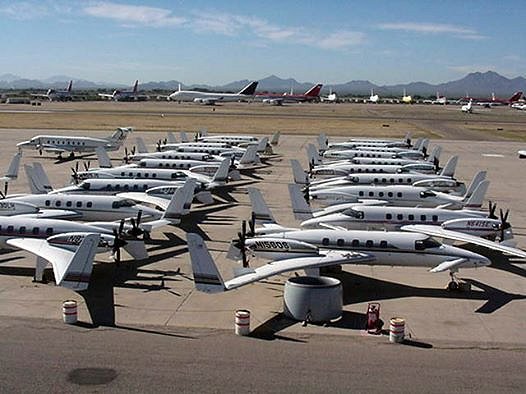 And this is where all but a few ended up - in the boneyard. What a waste!
|
 |
February 15, 2007 |
